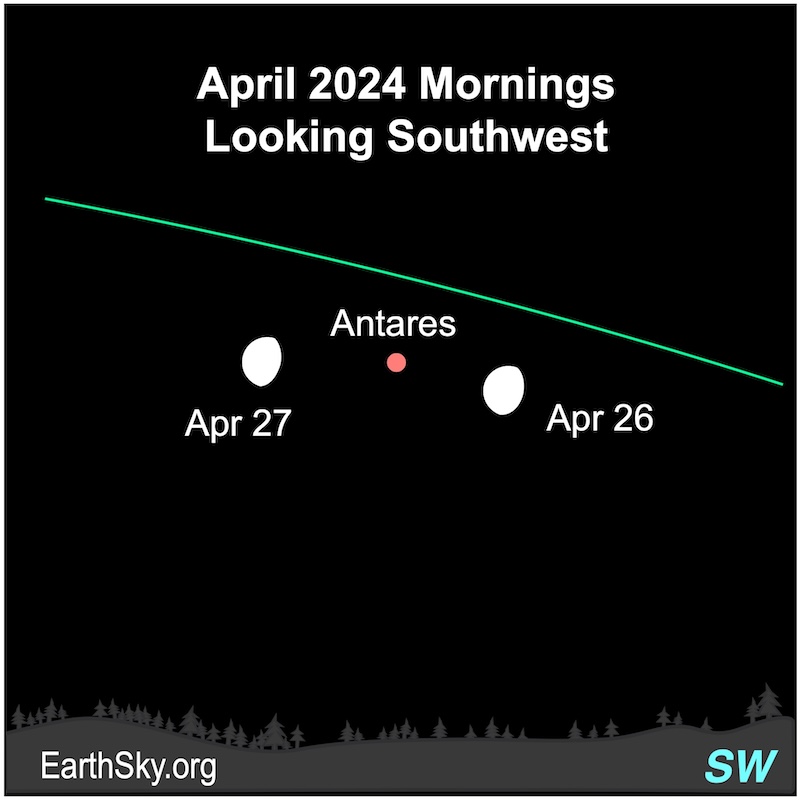
Daytime Moon is Up After Sunrise Now
Originally published by EarthSky.

Peter Lowenstein caught the daytime moon in its waning gibbous phase from Mutare, Zimbabwe. He said: “Three-quarters of an hour after sunrise, I photographed the daytime moon descending toward the top of a flowering African Tulip (Spathodia campanulta) tree.” Thank you, Peter!
Watch for a daytime moon
This month’s full moon came on the night of April 23, 2024. By April 25, the moon is in a waning gibbous phase, rising later and later each successive night. For those at temperate latitudes in the Northern Hemisphere, there’s an especially long time between moonrises on successive evenings around now. The April 25 moon will rise more than two hours after sunset. The April 26 moon will rise roughly to three hours after sunset.
And, of course, a later rising time means a later setting time. That’s why the mornings after a full moon are a good time to catch a nearly full daytime moon over your western horizon after sunrise. Watch for it!
The moon is up in the daytime half of the time. But, because it’s pale against the blue sky, it’s not as noticeable during the day as at night. Still, there are certain windows each month during which the daytime moon is most noticeable.
By April 26 and 27 mornings, moon near Antares
By the mornings of April 26 and 27, 2024 (or late evening of April 25 and 26), the moon will be near the bright star Antares in the constellation Scorpius the Scorpion. At that time, the moon will be rising a little before midnight at mid-northern latitudes. And it’ll still be up after the sun rises, but appearing thinner in phase and higher in the sky with each new dawn.

On the mornings of April 26 and 27, 2024, the waning gibbous moon will lie close to the bright star Antares in Scorpius the Scorpion. They’ll be visible from after midnight until dawn.
Because of Earth’s motion around the sun, Antares – like all the fixed stars (stars that appear not to move relative to one another) – will rise about four minutes earlier each evening. Meanwhile, because of its own motion around Earth, the moon will be rising later and later each evening thus moving away from Antares’ location in the sky.
Day by day, in the days ahead, the lighted portion of the waning gibbous moon will shrink. The half-lit last quarter moon will come late at 10:15 p.m. CDT April 30 (03:15 UTC on May 1), 2024.
Bottom line: You can easily spot the moon in the morning sky – after sunrise – for a few days after the full moon. Look west after the sun comes up!
Rocket Launches can sometimes be seen in Garrett County. Especially those from Wallops Island.
Originally published by Spaceflight Now, and Time and Date.
April
April 1: Global Astronomy Month. Led by Astronomers Without Borders, a non-profit organization, the month-long event encourages people to share the sky.
April 8: A total solar eclipse takes place across Mexico, the USA, and Canada. Roughly 45 million people live along the path of totality for this eclipse.
April 8: This is the third Super New Moon in a row, and the final one for 2024. (There will be Super Full Moons in September and October.)
April 8: A United Launch Alliance Delta 4-Heavy rocket will launch a classified spy satellite cargo for the U.S. National Reconnaissance Office. The largest of the Delta 4 family, the Heavy version features three Common Booster Cores mounted together to form a triple-body rocket. This is the final flight of a Delta 4 rocket. Delayed from March 28.
April 21/22: The Lyrid meteor shower is expected to peak around April 21 and 22, depending on your location.
April 23: April’s Full Moon is traditionally known as the Pink Full Moon.





